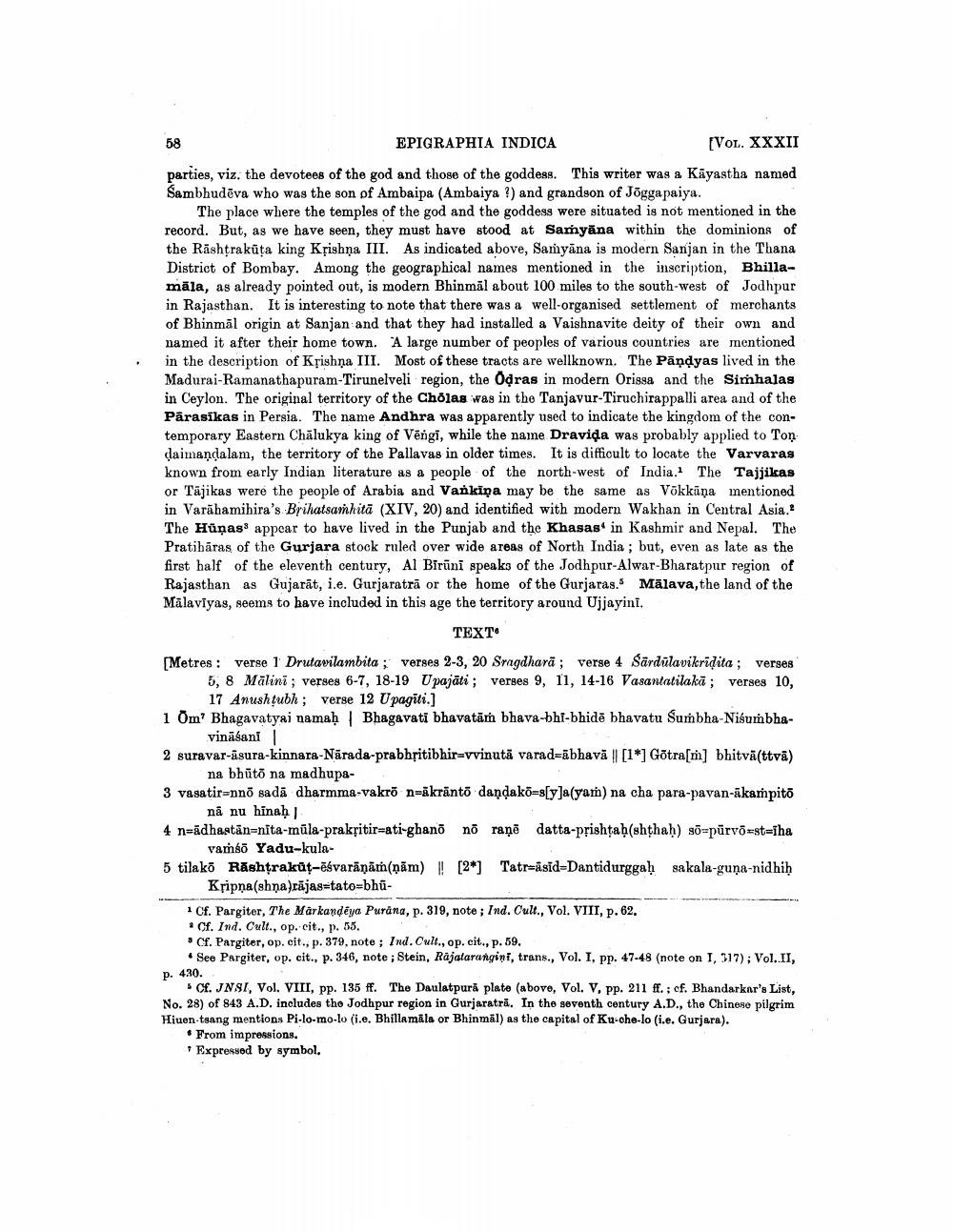________________
EPIGRAPHIA INDICA
[VOL. XXXII
parties, viz. the devotees of the god and those of the goddess. This writer was a Kāyastha named Sambhudēva who was the son of Ambaipa (Ambaiya ?) and grandson of Jõggapaiya.
The place where the temples of the god and the goddess were situated is not mentioned in the record. But, as we have seen, they must have stood at Samyäna within the dominions of the Rāshtrakūta king Kțishna III. As indicated above, Samyāna is modern Sanjan in the Thana District of Bombay. Among the geographical names mentioned in the inscription, Bhillamāla, as already pointed out, is modern Bhinmäl about 100 miles to the south-west of Jodhpur in Rajasthan. It is interesting to note that there was a well-organised settlement of merchants of Bhinmāl origin at Sanjan and that they had installed a Vaishnavite deity of their own and named it after their home town. A large number of peoples of various countries are mentioned in the description of Kệishna III. Most of these tracts are wellknown. The Pāņdyas lived in the Madurai-Ramanathapuram-Tirunelveli region, the Odras in modern Orissa and the Sinhalas in Ceylon. The original territory of the Cholas was in the Tanjavur-Tiruchirappalli area and of the Pārasīkas in Persia. The name Andhra was apparently used to indicate the kingdom of the contemporary Eastern Chālukya king of Vēngi, while the name Dravida was probably applied to Ton daimaņdalam, the territory of the Pallavas in older times. It is difficult to locate the Varvaras known from early Indian literature as a people of the north-west of India. The Tajjikas or Tājikas were the people of Arabia and Vankiņa may be the same as Võkkāņa mentioned in Varāhamihira's Brihatsamhita (XIV, 20) and identified with modern Wakhan in Central Asia. The Hüņas: appear to have lived in the Punjab and the Khasas in Kashmir and Nepal. The Pratibāras of the Gurjara stock ruled over wide areas of North India ; but, even as late as the first half of the eleventh century, Al Bīrūni speaks of the Jodhpur-Alwar-Bharatpur region of Rajasthan as Gujarāt, i.e. Gurjaratrā or the home of the Gurjaras. Mālava, the land of the Mālaviyas, seems to have included in this age the territory around Ujjayini,
TEXT
[Metres : verse 1 Drutavilambita, verses 2-3, 20 Sragdharā; verse 4 Sārdūlavikridita; verses
5,8 Mālini; verses 6-7, 18-19 Upajāti; verses 9, 11, 14-16 Vasantatilakā; verses 10,
17 Anushtubh ; verse 12 Upagiti.] 1 Om Bhagavatyai namah | Bhagavati bhavatām bhava-bhi-bhidë bhavatu Surbha-Nisumbha
vināšani 2 suravar-āsura-kinnara-Nārada-prabhsitibhir=vvinutā varad=ābhavā || [18] Götra[m] bhitvā(ttva)
na bhūto na madhupa3 vasatir=nno sadā dharmma-vakro n=ākrānto dandakõ=s[y]a(yam) na cha para-pavan-ākampito
nā nu hinah 4 n=ādhastān=nita-mula-prakritir=ati-ghano no raņē datta-prishtaḥ(shthah) sõ=pūrvõ=st=iha
vambo Yadu-kula5 tilako Rāshțrakut-ēsvarāņām(ņām) !! [2*] Tatr=āsid=Dantidurggaḥ sakala-guna-nidhiḥ
Ksipņa(shna)rājag=tato=bhū1 Cf. Pargiter, The Markandeya Purana, p. 319, note; Ind. Cult., Vol. VIII, p. 62. * Cf. Ind. Cult., op. cit., p. 55. * Cf. Pargiter, op. cit., p. 379, note ; Ind. Cult., op. cit., p. 59.
See Pargiter, op. cit., p. 346, note; Stein, Rajatarangini, trans., Vol. I, pp. 47-48 (note on I, 317); Vol. II, p. 430.
Cf. INSI, Vol. VIII, pp. 135 ff. The Daulatpură plate (above, Vol. V, pp. 211 ff.; cf. Bhandarkar's List, No. 28) of 843 A.D. includes the Jodhpur region in Gurjaratrā. In the seventh century A.D., the Chinese pilgrim Hiuen-tsang mentions Pi-lo-mo-lo (i.e. Bhillamila or Bhinmäl) as the capital of Ku-che-lo (i.e. Gurjara).
• From impressions. * Expressed by symbol.




